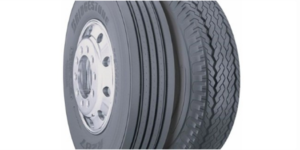While truck manufacturers are steadily introducing technical advances in cabs and trailers, tire makers are using new technologies to improve truck tires. These improvements are bringing increased efficiencies and safety to the trucking industry:
Lower Rolling Resistance Means Better Fuel-Efficiency
In trucking, especially in the long haul segment, fuel efficiency is more important than ever. Tire makers use something called a rolling resistance index to rank tires for fuel-efficiency. Until recently, they have been challenged in finding ways to lower rolling resistance without sacrificing levels of tread wear and durability. But, new technologies involving the use of silica tread rubber combined with more rigid tread designs have provided a solution.
https://www.bridgestonetire.com/tread-and-trend/tire-talk/tire-rolling-resistance
According to Phil Mosier, Manager of Commercial Tire Development for Cooper Tire, “With the use of advanced materials, the performance attributes of a tire can be expanded to realize improvements in rolling resistance while maintaining or improving other key attributes in the tire like tread wear and durability.’
http://www.feedspot.com/?dadi=1#feed/f_3644255/article/5619128221?dd=4311522791154675
Manufacturing Advances are Giving Longer Life to Tires
New tire manufacturing processes have made advanced siping possible. While this has helped to lower the rolling resistance, it has also improved casings, adding real savings in a tire’s overall lifecycle cost by making them more retreadable than previous designs.
https://en.wikipedia.org/wiki/Siping_(rubber)
Significant innovations in retread technology have added to tire life. It is providing a way for fleet operators to save money while keeping their trucks’ tires in ideal condition. Bridgestone’s Bandag TR4.1 a retread for its Ecopia tire line provides a way to extend the useful life of the tire and thereby lower the total cost of ownership per mile by keeping the tire casing running longer. Another example is Goodyear. Their engineers have developed UniCircle retread technology, aimed at “extending the life of tire casings by providing a seamless construction and a precise fit to deliver a repeat performance.”
https://www.truckinginfo.com/156555/how-truck-tires-have-evolved
Advances in rubber chemistry and the ability to blend different compounds for specific areas of the tire have led to new tire designs optimized for wear. One example is Michelin’s truck tires,. Their unique energy” compounds in their sidewall designs have resulted in a “significant reduction in irregular wear for up to 15% improvement in removal mileage”, according to Paul Crehan, Director of Product Marketing.
Tire Pressure Monitoring Systems (TPMS) are Improved
Advanced technology associated with TPMS is resulting in healthier tires that last longer. Problems associated with under-inflation, namely excessive heating leading to tire failure, can be avoided. Active pressure monitoring is real-time and constant, avoiding the issues associated with a manual process that can be sporadic and prone to errors.
At DriverSource, we realize that high-quality, well-maintained tires play a big role in the overall safety of trucking. Constant improvements in tire manufacturing are helping to make trucking safer as well as improve fuel efficiency. And, that’s good for everyone.
Bill D for DriverSource


